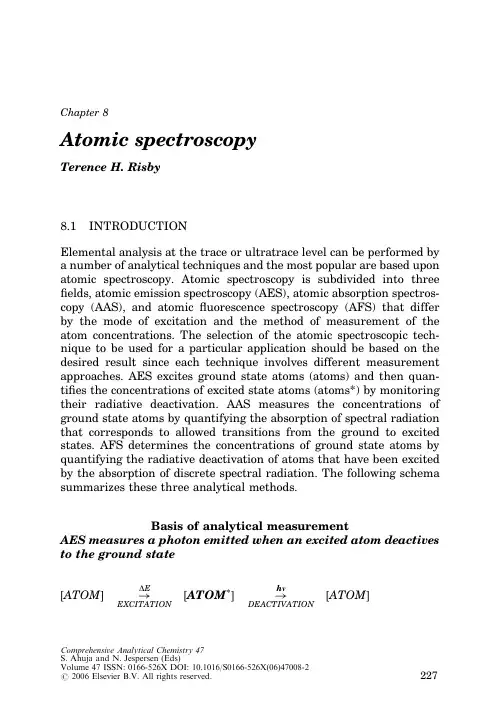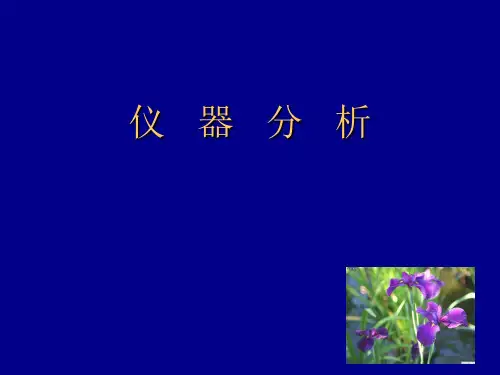优选第八章仪器分析法多图
- 格式:ppt
- 大小:11.94 MB
- 文档页数:79



Chapter8Atomic spectroscopyTerence H.Risby8.1INTRODUCTIONElemental analysis at the trace or ultratrace level can be performed by a number of analytical techniques and the most popular are based upon atomic spectroscopy.Atomic spectroscopy is subdivided into three fields,atomic emission spectroscopy(AES),atomic absorption spectros-copy(AAS),and atomicfluorescence spectroscopy(AFS)that differ by the mode of excitation and the method of measurement of the atom concentrations.The selection of the atomic spectroscopic tech-nique to be used for a particular application should be based on the desired result since each technique involves different measurement approaches.AES excites ground state atoms(atoms)and then quan-tifies the concentrations of excited state atoms(atoms*)by monitoring their radiative deactivation.AAS measures the concentrations of ground state atoms by quantifying the absorption of spectral radiation that corresponds to allowed transitions from the ground to excited states.AFS determines the concentrations of ground state atoms by quantifying the radiative deactivation of atoms that have been excited by the absorption of discrete spectral radiation.The following schema summarizes these three analytical methods.Basis of analytical measurementAES measures a photon emitted when an excited atom deactives to the ground state½ATOM !D EEXCITATION ½ATOMà !h mDEACTIVATION½ATOMComprehensive Analytical Chemistry47S.Ahuja and N.Jespersen(Eds)Volume47ISSN:0166-526X DOI:10.1016/S0166-526X(06)47008-2r2006Elsevier B.V.All rights reserved.227AAS measures a photon absorbed when a ground state atom is excited½ATOM !h mEXCITATION ½ATOMà !h nDEACTIVATION½ATOMAFS measures a photon emitted when an excited atom deactives to the ground state½ATOM !h nEXCITATION ½ATOMà !h mDEACTIVATION½ATOMBrief history.Analytical atomic spectroscopy has taken more than 200years to become the most widely used method for elemental ana-lysis.Thomas Melville was thefirst to describe the principles offlame AES in1752,but it took another100years before Kirchoff and Bunsen (1860)proposed the potential analytical relationship between ground or excited state atoms and the absorption or emission of discrete spectral radiation.All of these pioneering studies were performed by introducing solutions of metals by various means into alcoholflames orflames sup-ported on Bunsen burners.However,the analytical utility of these early studies were limited by reproducibility of the analytical signal and this limitation was not solved until1929when Lundegardh introduced new designs for burners,nebulizers,gas control devices,and detection systems. These instrumental advances were used in most of the earlyflame pho-tometers.Although Kirchoff and Bunsen had introduced the concept of atomic absorption in their original studies,it was not until1955that Walsh and his collaborators developed analytical AAS.This advance was due to their development of the sealed hollow cathode lamp as a spectral source of radiation that avoided the need for high-resolution monochromators to select and resolve the absorption lines.Eight years later Alkemade (1963)and Winefordner(1964)independently introduced the idea of an-alytical AFS.Finally in the1960s and1970s researchers(L’vov,Greenfield, Fassel,and West)introduced nonflame atomizers in order to mini-mize the spectral and chemical interferences that often occur inflames.8.2THEORY8.2.1Atomic emission spectroscopyAES quantifies discrete radiation that is emitted by an excited atom when it deactivates to the ground state.This energy of excitation isT.H.Risby228Atomic spectroscopyprovided by thermal,chemical,or electrical means.If the atom reser-voir is in thermodynamic equilibrium then the Boltzmann distribution law gives the concentrations of atoms in the excited and ground states:N j=N o¼ðg j=g oÞeÀE j=KTwhere N j and N o are the number densities of atoms in the excited(j th state)and ground states,g j and g o the statistical weights of these states, E j the energy difference between the j th and ground states,K the Boltzmann constant;and T the temperature(K)of the atom reservoir. The Boltzmann distribution law can only be used if excitation is pro-duced by thermal collisions;the dominant process of excitation in flames.This equation is not valid to explain excitation caused either by chemical reactions inflames or by energetic collisions with excited species(electrons,ions,metastable atoms)that occur in electrical dis-charges or plasmas.The concentration of atoms in the excited state is measured by monitoring their spectral deactivation to the ground state.The radiant power of this mechanism of deactivation is given by:P¼ðhv o=4PÞðg j=g oÞA j!o l½M eÀE j=KTwhere P is theflux of radiant energy per unit of solid angle and per unit surface area in a direction perpendicular to theflame surface.A j-o is the transition probability per unit time of the transition from the j th to the ground state,and l is the thickness of atom reservoir along the axis of observation from which the emitted photons are monitored.[M]is the concentration of metal atoms and hv o is the energy of the emitted photon.This equation demonstrates that the radiant power of the spectral deactivation is directly proportional to the concentration of the atoms and this linear relationship is followed providing that no inter-ferences such as self-absorption occur.Self-absorption is the absorption of radiation by ground state atoms and this interference increases with the concentration of atoms.Also,this equation shows that small var-iations in temperature will produce larger variations in the radiant energy.8.2.2Atomic absorption spectroscopyAAS measures the discrete radiation absorbed when ground state atoms are excited to higher energy levels by the absorption of a photon of energy.The radiant power of the absorbed radiation is related to the absorption coefficient of the ground state atoms using the229Beer Lambert equation:I ðl Þ¼I o ðl Þ10ÀK ðl Þbwhere I o (l )is the radiant power of the incident radiation of wavelength l ,I (l )the radiant power of the transmitted radiation at wavelength l ,K (l )the absorption coefficient of the ground state atom at wavelength l ,and b the path length.This equation can be expressed in terms of absorbance (A (l ))where:A ðl Þ¼log I ðl Þ=I o ðl ÞÀÁ¼K ðl ÞbThe usual method of excitation of the ground state atoms is to use an elemental spectral source (often a hollow cathode lamp)that emits the atomic spectra of the analyte element.If the width of the emission line from the spectral source is negligible compared to the absorption line of the ground state atoms,and if it is assumed that the ab-sorption profile is determined by Doppler broadening,then the ab-sorption coefficient integrated over the absorption-line profile can be approximated by the absorption coefficient at the absorption peak maximum (K max ).The relationship between K max and the number density of ground state atoms is given by the following equation:K max ¼2l 2=l D ÀÁl n 2=PÀÁ0:5P e 2=mc 2ÀÁN o f where l D is the Doppler width of the line;l the wavelength of the absorption maxima;e and m the charge and mass of an electron,res-pectively;c the velocity of light;and f the oscillator strength (average number of electrons per atom that can be excited by the incident radi-ation (l )).Therefore,the absorbance is directly proportional to the concentration of atoms,provided that the absorption profile is domi-nated by Doppler broadening.8.2.3Atomic fluorescence spectroscopyAFS quantifies the discrete radiation emitted by excited state atoms that have been excited by radiation from a spectral source.There are a number of mechanisms that are responsible for the atomic fluorescence signal:resonance fluorescence,step-wise fluorescence,direct-line fluo-rescence,and sensitized fluorescence.Generally,the lowest resonance transition (1-0)is used for AFS.If a line source is used for excitation and if the atomic vapor is dilute,then the radiant power of the atomic T.H.Risby230fluorescence signal (I f )can be related to the concentration of ground state atoms by the following equation:I f ¼e 2O f L l 2f d F I L O A N o ÀÁ6P mc 2D l D ðÞ2l n 2PÀÁwhere O f /4p and O A /4p are the solid angles of fluorescence and exci-tation that are measured by the instrument,or are incident upon the atom reservoir,respectively;L the length of the atom reservoir in the analytical direction;F the atomic fluorescence quantum efficiency;I L the integrated radiant power for the incident beam per unit area;@a correction factor that accounts for the relative line widths of the source and absorption profiles;and D l D the Doppler half width of the fluores-cence profile.On the basis of this equation it can be seen that the radiant power of atomic fluorescence signal is directly proportional to the concentration of the ground state atoms and to the radiant power of the exciting radiation.Therefore,increasing the intensity of the incident beam will improve the sensitivity of the technique.8.3INSTRUMENTATIONThe following block schemas show the essential instrumental features of the various atomic spectroscopy techniques.Clearly,there are many similarities between these techniques.The subsequent discussions will describe the instrumental components of these tech-niques.Atomic emissionspectroscopy ATOM RESERVOIRMONOCHROMATORPHOTOMULTIPLIER READ OUT SYSTEMAtomic absorptionspectroscopyATOMRESERVOIRMONOCHROMATORPHOTOMULTIPLIER READ OUT SYSTEM SPECTRAL SOURCE Atomic spectroscopy231AtomicfluorescencespectroscopyATOM RESERVOIRMONOCHROMATORPHOTOMULTIPLIER READ OUT SYSTEMSPECTRAL SOURCE8.3.1Atom reservoirsThe production of atoms is a common critical requirement of all these techniques and there are various devices that can be used to generate the atoms in analytically useful spectroscopic states.The following schema summarizes the processes that occur during atomi-zation:Atomization½SOLUTION !NEBULIZATION ½AEROSOL !DESOLVATION½SOLID !VOLATILIZATION½VAPOR !DISSOCIATION½ATOM8.3.1.1Flame atomizersFlames have been traditionally the most popular atom reservoirs for all atomic spectroscopic techniques since they provide the most convenient way to generate atoms.Typically,solutions are aspirated into the ox-idizer gas of a premixed hydrocarbonflame via a pneumatic nebulizer. Direct nebulizers pass the entire liquid aerosol that is generated into theflame,whereas indirect nebulizers pass only liquid aerosol particles of a given size and size distribution.During passage through theflame, the aerosol particles are desolvated,dissociated,and atomized.The efficiencies and reproducibilities of these processes will define the limit of detection that can be obtained and therefore considerable effort has been expended in developing efficient and quantitative nebulizers and atom reservoirs.The size and distribution of the aerosol particles will play a major role in the atomization efficiency since if the aerosol drop-lets are too large they may have insufficient residence time in theflame to be completely atomized or if the aerosol droplets are too small they can be desolvated in the nebulizer and be lost by collisions with the walls.Therefore,for a given composition offlame gases and burnerT.H.Risby232Atomic spectroscopythere will be an optimum size and size distribution for the aerosol particles.The residence time available in theflame for atomization of the sample is dependent upon theflow rates of the fuel and oxidizer, and theseflow rates are determined by the burning velocities of the particularflame gas mixture.Most atomic spectrometers employ indi-rect pneumatic nebulizers to generate a liquid aerosol of optimum size and size distribution and for these devices only about10%of the as-pirated sample reaches theflame.Theflame properties will also affect the atomization efficiency.The most popularflames used in analytical atomic spectroscopy are air–acetylene or nitrous oxide–acetylene.The former has aflame tem-perature of approximately23001C and the latter28001C.The increased atomization efficiency of the nitrous oxide–acetyleneflame is not solely the result of the increase inflame temperature since thisflame contains significant concentrations of excited cyanogen radicals(CN*)whose presence in theflame is exhibited by the emission of molecular bands in the region650nm(known as the red feather).The nitrous oxide–acetyleneflame is recommended for those elements that form stable molecular species,such as refractory oxides,which can persist through theflame without atomization(such as aluminum,barium,beryllium, calcium,scandium,silicon,tantalum,titanium,uranium,vanadium, tungsten,zirconium,the lanthanides,and the rare earths).High con-centrations of the reactive excited cyanogen radicals will reduce re-fractory oxides to atoms.The cooler air–acetyleneflame is preferred for a different group of elements that have low ionization potentials(such as lithium,sodium,potassium,rubidium,and cesium).The hotterflame could ionize these elements with the result that the atom concentra-tions of the analyte species are reduced.There are a number of dis-advantages to the use offlames as atom reservoirs and the most notable are the quantity of sample required for analysis,the brief residence time spent by the atom in the analytical zone of theflame,and the chemical environment within theflame.As a result,a number of non-flame atom reservoirs have been developed that generate atoms by electrical energy in controlled inert environments.8.3.1.2Nonflame atomizersNonflame atom reservoirs have been developed for specific atomic spectrometric techniques.Electrothermal atomizers(carbon rods,car-bon furnaces,or tantalum ribbons)have been developed for AAS or AFS since they require the generation of ground state atoms,whereas233T.H.Risbyatmospheric pressure inductively coupled argon plasmas have been used to produce excited atoms for AES.8.3.1.3Electrothermal atomizersThe use of resistively heated carbon or tantalum rods,tubes,orfila-ments to generate atoms by thermal energy has increased the sensitiv-ities of AAS and AFS by factors of40–4000.The majority of this improvement in sensitivity is the result of increased residence time that the ground state atoms spend in the analytical zone,with minor con-tributions due to the reductions in chemical or spectral interferences from theflame.Some of the materials of construction of these atomizers can also play a role in the atomization processes since for example hot carbon can increase the reduction of the analyte species.The mode of sample introduction for these atomizers is to introduce a discrete aliquot of sample into the atomizer with a microsyringe(sample sizes are ap-proximately5m l).The analyte is then dried,ashed,and atomized suc-cessively by resistive heating of the atomizer with a time-controlled ramp of low-voltage,high-current electricity.As a result of this mode of sample introduction,the analytical response is a transient pulse as op-posed to a steady-state signal that is produced when a sample is ne-bulized continuously into aflame.Theoretically,the repeatability of the response obtained by electrothermal atomization should be lower than theflame since the peak signal for the former is dependent upon the precision with which the volume of the sample can be introduced.How-ever,the electrothermal atomizers can be carefully controlled so that optimum temperatures can be obtained to dry,ash,and atomize the sample,which is not possible withflames.Also automatic syringes (usually injecting50m l)can be used to introduce the sample into the non-flame atomizer.Electrothermal atomizers can ash the sample in situ to destroy the sample matrix,which is a major advantage since flame atomizers require samples to be preashed.This advantage can also present difficulties unless precautions are taken to correct for absorption due to molecular species by background correction.The absorption profiles of molecular species are broad compared to the absorption profiles of atomic species.Currently,most instrument man-ufacturers use graphite furnace technology,which is based upon the research by L’vov from the early1970s.The major advantage of the graphite furnace is that the atom vapor is maintained in the ana-lyzer cell for significant periods of time allowing quantification to be performed.Also it is easy to generate reproducible temperature–time ramps to dry,ash,and atomize the elements of interest.234Atomic spectroscopy8.3.1.4Inductively coupled plasmasGreenfield and Fassel independently proposed the use of atmospheric pressure inductively coupled argon plasmas as atom reservoirs for atomic spectroscopy.This proposition has revolutionized thefield of AES since this atom reservoir produces large concentrations of excited atoms for most elements in the periodic table.The plasma torch is produced by inductively coupling a high level(1.5kW)of radio fre-quency energy(around30MHz)to aflowing stream of argon.This energy causes the argon to be ionized and various energetic species are produced,such as metastable argon atoms,excited argon atoms,argon ions and energetic electrons.These species will collide with the analyte to produce excited atoms and ions via various fragmentation and ex-citation mechanisms.The plasma torch has sufficient energy to excite most elements and will also populate multiple energy levels for a given element with the result that this atom reservoir is useful for multielement analysis.The population of different energy states for a given element allows more sensitive lines to be used for trace levels of analytes and less sensitive lines for higher concentrations of analyte atoms.This capability enables wide concentrations of samples to be determined without the problem of nonlinearity of response versus concentration.The analyte solutions are nebulized into the argon sup-port using an ultrasonic nebulizer(3MHz)and desolvation system.The desolvation system is necessary since this nebulizer is more efficient than pneumatic nebulizers and without predesolvation the plasma is cooled significantly.Inductively coupled plasmas have also been used successfully as the ionization source for elemental analysis by mass spectroscopy replacing arc and spark sources.8.3.2Spectral sources8.3.2.1Continuous sourcesHigh-pressure electrical discharges were thefirst sources used in atomic spectroscopy.These sources consist of a sealed tubefilled with a gas containing two electrodes.A voltage is applied between the electrodes and at a given voltage an electrical discharge is initiated.Electrons are accelerated by the potential difference between the electrodes and collide with thefiller gas to produce excited molecules,atoms,and ions.At low gas pressures,the predominant output from these lamps is atomic line spectra characteristic of thefiller gas,but as the pressure is increased the spectral output is broadened and a continuous spectra are produced. Hydrogen,deuterium,and xenon are the most widely used gases.235T.H.Risby8.3.2.2Line sourcesHollow cathode lampsThe introduction of sealed hollow cathode lamps by Walsh and his col-laborators was the single event that revolutionized thefield of atomic spectroscopy in the mid-1950s.These devices consist of a hollow cylin-drical cathode manufactured from the element of interest.This cathode and an anode are sealed inside an optically transparent envelope with a quartz front window that is inline with the cathode.The lamp isfilled with a low pressure(1–3torr)of an inert gas(usually neon or argon). The hollow cathode lamp operates by producing inert gas discharge that sputters or vaporizes the element of interest from the cathode.These atomic species are subsequently excited by collision with inert gas ions, energetic inert gas atoms,or electrons to produce excited atoms that deactivate by the emission of characteristic photons.Cathodes can even be manufactured from nonelectrically conducting materials by the judi-cious choice of alloys.Once the discharge is struck a stable glow dis-charge is produced and the hollow cathode lamps can be operated with the minimum current.This operating procedure maintains a stable discharge and ensures that the spectral line output is not broadened. Hollow cathode lamps are available for most of the elements in the periodic table and multielement sources have been made using cath-odes manufactured from mixtures of elements.Electrodeless discharge lampsIn the1960s and1970s,Rains,West,Dagnall,and Kirkbright developed electrodeless discharge tubes as intense line sources for AAS and AFS. These lamps are easy to manufacture in the laboratory and consisted of sealed quartz tubes containing the element of interest or its halide,and low pressure(1–3torr)of an inert gas usually argon.Energy in the microwave region(2.45GHz)is supplied to the tube by placing it in a resonant cavity.The discharge is initiated by supplying electrons with a Tesla coil and intense atomic spectra of the element are obtained. Typically,these lamps produce higher intensity atomic spectra than the corresponding hollow cathode lamp however often the spectral outputs of these lamps are less stable.8.3.3MonochromatorsThe requirements for wavelength dispersion are very different for AES as compared to the spectral requirements of AAS and AFS.For AES it is essential to monitor only the radiation that results from 236the desired atomic transition and high-resolution monochromators (dispersion41.6nm/mm of slit width)are required.The usual mode of operation is to monitor the intensity at a selected wavelength and then repeat the determination at a different wavelength.However,induc-tively coupled plasma-AAS with its ability to perform concurrent multi-element analysis requires a different design of monochromator.The most popular design involves monitoring thefirst-order spectrum of a concave grating spectrometer by placing suitable photosensitive devices on the Rowland circle.These photosensitive devices can be a photodiode array in which each element in the array can be monitored separately or else multiplefixed exit slits with photomultipliers placed at each slit. This latter arrangement is often called a quantometer or polychroma-tor.Obviously there are a limited number of wavelengths that can be measured with this type of spectrometer with photomultipliers al-though advances in photodetection devices are reducing this limitation. The wavelength dispersion requirements for AASs and AFS are much less demanding than AES since the hollow cathode lamp is already producing radiation that is characteristic of the element under inves-tigation.Therefore,the monochromator has only to separate the emis-sion line of interest from other nonabsorbing lines.Theoretically, interferencefilters could replace these monochromators.8.3.4Read-out systemsPhotomultipliers are generally used to convert the spectral radiation to an electrical current and often phase-sensitive lock-in amplifiers are used to amplify the resulting current.AES and AFS require similar read-out systems because both methods are measuring small signals.The diffi-culty associated with both these methods is the separation of the signal for the atomic transition of interest from the background radiation emitted by excited molecular species produced in the atom reservoir.AFS phase locks the amplifier detection circuit to the modulation frequency of the spectral source.Modulation of the source is also used in AAS.8.4GENERAL CONSIDERATIONS8.4.1Atomic emission spectroscopyAES quantifies the deactivation of excited atoms.Atom reservoirs will also produce excited molecules that could interfere with the sub-sequent analysis since emission from excited molecular species is broad237compared to the emission from excited atomic species.Multielement AES can identify and quantify concurrently all the elements contained in a sample,which is a major advantage compared to the single-element techniques,atom absorption,and AFS.Until the introduction of in-ductively coupled plasmas as atom reservoirs for AES,the number of elements that could be determined was limited by the availableflame energy.Only those elements with low excitation energies could be de-termined unless arcs or sparks atom reservoirs were used.These latter types of atom reservoirs are not suitable for trace and ultratrace ana-lysis as a result of extensive molecular spectral interferences.The cur-rent awareness of the importance of complex antagonistic and/or synergistic interactions between elements has increased the interest in rapid multielement analyses and inductively coupled plasma-AES is ideally suited for this application.Internal standards are generally added to the sample to aid identification and the selection of internal standards(such as gallium and yttrium)is based on the composition of the matrix.These elements enable chemical or spectral interferences to be subtracted.Theoretically,the inductively coupled plasma source should have sufficient energy to atomize all the elements in the sample and sample pretreatment should be minimal.8.4.2Atomic absorption spectroscopyThe instrumental requirement and cost of atomic absorption spectro-meters are considerably less than those for multiwavelength atomic emission spectrometers.AAS quantifies the concentration of the ele-ment on the basis of the absorption of radiant energy by ground state atoms and the analytical response is based on the difference between the incident radiation and the transmitted radiation,i.e.,the difference between two large signals.Therefore,it is imperative to use a spectral source with a very stable spectral output unless a double-beam spec-trometer is used.Generally,the radiation from the spectral source is electronically modulated so that it can be selectively amplified with a lock-in amplifier.This mode of detection discriminates against the continuous background radiation from other species present in the atom reservoir.The usual sources of radiation for AAS are hollow cathode lamps that are available for most elements.The major limi-tation of AAS is the need to use a different hollow cathode lamp for each element since the spectral stability of multielement hollow cathode lamps is often poorer than single-element lamps.No spectral interfer-ences from other elements are observed with AAS although spectral 238interferences can be produced by molecular species.Molecular spectral interferences can be minimized by the use of background correction with a hydrogen or deuterium continuum source or on the basis of the Zeeman effect,which occurs when energy levels are split by placing atoms in an external magneticfield.Molecular interferences are more significant with electrothermal atomizers than withflames.Since the magnitude of the absorbance is proportional to the path length,atom reservoirs have been designed so that the maximum concentration of ground state atoms are in the incident beam which is exactly opposite to the designs for atomic emission to AFS.The latter sources should be thin in the direction of measurement to avoid self-absorption.AAS can be used to quantify selectively any element that can be produced in the ground state,provided that a suitable spectral source is available. These spectral sources also allow facile optimization of the monochro-mator to the absorption maximum.The analytical response is displayed as a percent transmission or else as the logarithm of the percent trans-mission by the use of logarithmic amplifiers.8.4.3Atomicfluorescence spectroscopyThe instrumental requirements of AFS are the same as that of AAS with the exception that the incident radiation is at right angles to the analytical measurement direction.The atomicfluorescence signal is amplified with a phase-sensitive amplifier that is locked into the modu-lated incident radiation.AFS is more sensitive than AAS since the limit of detection is defined as the minimum detectable signal as opposed to minimum difference that can be measured between two large signals. Theoretically,the excitation source can be a continuum source,since only the radiation that has the energy that corresponds to the electronic transition will be absorbed and therefore the atom reser-voir is acting as a high-resolution monochromator.However,prac-tically most continuum sources do not have sufficient intensity at the wavelength of interest to produce analytically useful atomicfluo-rescence signals.AFS will quantify selectively any ground state atom that can be excited with incident radiation.The sensitivity of AFS is superior to the other atomic spectrometric techniques for a number of elements(Ag,Cu,Cd,Ni,Sb,Se,Te,Tl,and Zn).AFS is virtually free from spectral interferences although light scattering of the inci-dent radiation can occur when samples with high solid contents are analyzed.This interference only occurs if resonancefluorescence is studied.239。


